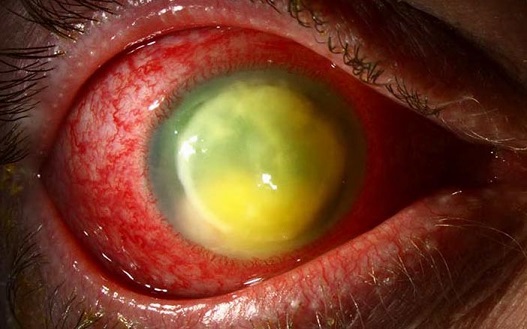Researchers warn of rising threat of eye infections caused by Pseudomonas aeruginosa
Nikhil Prasad Fact checked by:Thailand Medical News Team Aug 19, 2024 1 year, 3 months, 3 weeks, 6 days, 13 hours, 2 minutes ago
Medical News: Pseudomonas aeruginosa, a diverse and adaptable bacterium, is increasingly recognized as a major culprit in severe eye infections, particularly among contact lens users. These infections often lead to conditions like bacterial keratitis, which can have devastating effects on vision if not promptly and effectively treated. This
Medical News report delves into the role of Pseudomonas aeruginosa in corneal infections, its virulence factors, and the novel treatment approaches that are currently being explored to combat this resilient pathogen. The researchers involved in this comprehensive review hail from King Faisal University in Saudi Arabia and the Pondicherry Centre for Biological Science and Educational Trust in India.
 Researchers warn of rising threat of eye infections caused by Pseudomonas aeruginosa
The Growing Concern of Pseudomonas aeruginosa in Corneal Infections
Researchers warn of rising threat of eye infections caused by Pseudomonas aeruginosa
The Growing Concern of Pseudomonas aeruginosa in Corneal Infections
Pseudomonas aeruginosa is notorious for its role in bacterial keratitis, an infection that inflames and damages the cornea - the clear, dome-shaped surface that covers the front of the eye. The study highlights that bacterial keratitis is a serious condition that requires immediate medical attention. The use of contact lenses, particularly when hygiene is compromised, significantly increases the risk of infection. While contact lenses are convenient and widely used, they can also become breeding grounds for bacteria like Pseudomonas aeruginosa, especially when worn for extended periods or not cleaned properly.
How Pseudomonas aeruginosa Causes Infection
The virulence of Pseudomonas aeruginosa lies in its ability to form biofilms on the surface of contact lenses. Biofilms are protective layers that shield bacteria from the host's immune system and make them more resistant to antibiotics. The study finds that the hydrophilicity of contact lenses - meaning their ability to attract and retain moisture - can exacerbate the problem by providing an ideal environment for bacterial growth. This, combined with poor hygiene practices, can lead to severe infections that are difficult to treat.
In addition to biofilm formation, Pseudomonas aeruginosa produces a range of virulence factors that contribute to its pathogenicity. These include Exotoxin A (ExoA), which inhibits protein synthesis in host cells, leading to cell death and tissue damage. Another significant factor is pyoverdine, an iron-scavenging molecule that regulates the production of Exotoxin A and further enhances the bacterium's ability to cause disease.
Emerging Treatment Options
Given the increasing resistance of Pseudomonas aeruginosa to conventional antibiotics, researchers are exploring novel therapeutic approaches. One promising avenue is the use of antivirulence strategies that target the bacteria's ability to cause disease rather than trying to kill the bacteria outright. This approach minimizes the pressure on bacteria to develop resistance and could lead to more effective treatments in the long run.
Phage therapy is another innovative treatment b
eing investigated. This involves using viruses that specifically target and kill bacteria. In laboratory studies, bacteriophages have shown effectiveness against Pseudomonas aeruginosa, even in cases where the bacteria are resistant to antibiotics. Phage therapy could potentially be used in conjunction with traditional treatments to enhance their efficacy.
Challenges in Treating Pseudomonas aeruginosa Infections
Despite these advancements, treating Pseudomonas aeruginosa infections remains challenging. The bacterium's ability to form biofilms and produce various virulence factors makes it particularly difficult to eradicate. Moreover, the rise of multidrug-resistant (MDR) strains of Pseudomonas aeruginosa has compounded the problem. The article emphasizes the need for new treatment strategies that can overcome these challenges and provide more effective solutions for patients.
The Role of Nanotechnology in Drug Delivery
Nanotechnology is emerging as a potential game-changer in the treatment of eye infections. By delivering drugs directly to the site of infection, nanocarriers can increase the concentration of antibiotics in the eye and improve their effectiveness. The article highlights the development of polymer-based and lipid-based nanocarriers that can encapsulate drugs and deliver them in a controlled manner. These nanocarriers have shown promise in laboratory studies and could pave the way for more effective treatments in the future.
Conclusions
Pseudomonas aeruginosa remains a significant threat in the realm of eye infections, particularly among contact lens users. This review has highlighted the bacterium's role in bacterial keratitis and the various factors that contribute to its pathogenicity. As antibiotic resistance continues to rise, there is an urgent need for new treatment approaches that can effectively combat this resilient pathogen. Researchers are exploring innovative solutions such as antivirulence strategies, phage therapy, and nanotechnology-based drug delivery systems, all of which hold promise for improving patient outcomes.
Regular eye check-ups, proper hygiene, and timely treatment remain critical in preventing and managing bacterial keratitis. For contact lens users, it is essential to follow recommended cleaning practices and replace lenses as advised to minimize the risk of infection.
The study findings were published in the peer-reviewed journal: Pharmaceutics.
https://www.mdpi.com/1999-4923/16/8/1074
For more about eye infections caused by Pseudomonas aeruginosa, keep on logging to Thailand
Medical News.
Read Also:
https://www.thailandmedical.news/news/breaking-even-mild-covid-19-can-cause-microvasculature-changes-of-the-optic-nerve
https://www.thailandmedical.news/news/covid-19-infection-linked-to-rare-vision-loss-a-case-study
https://www.thailandmedical.news/news/covid-19-causes-changes-to-ocular-microbiome-which-can-affect-eye-health
